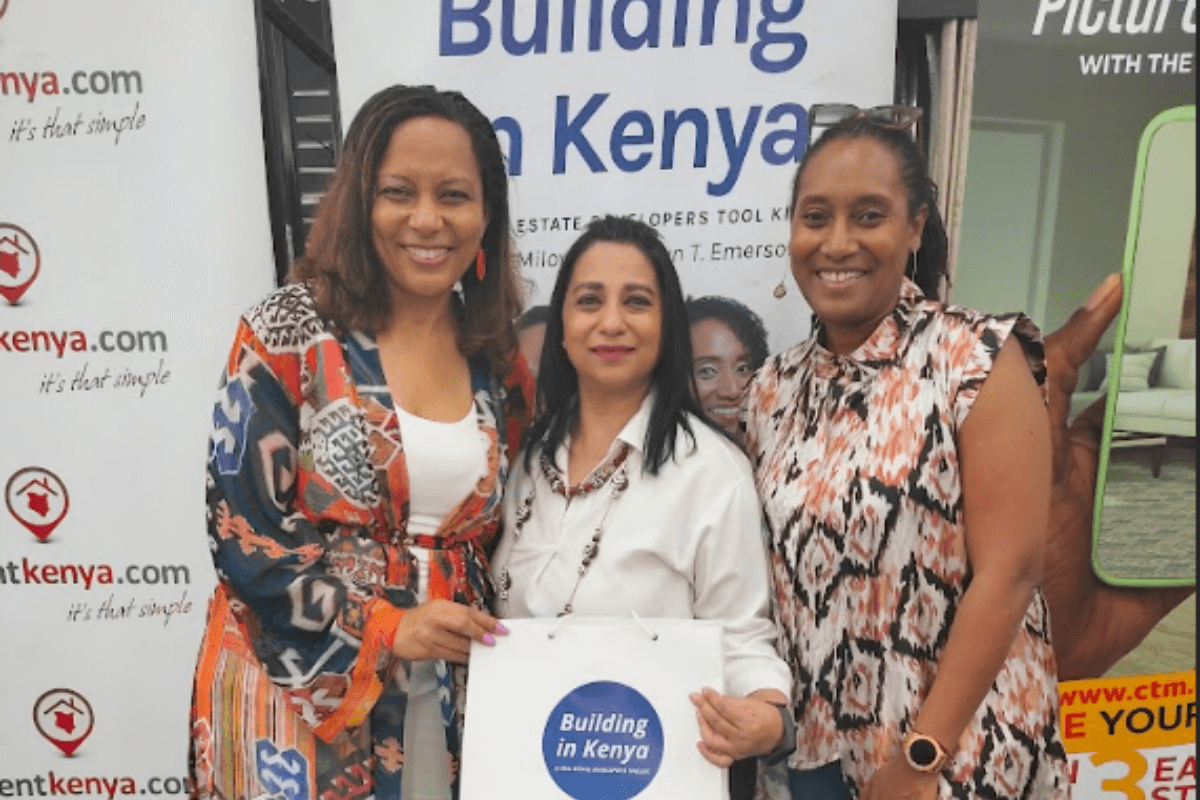In this exclusive interview, Emma Miloyo, an accomplished architect and partner at Design Source, shares her insights and experiences in the Kenyan real estate industry with Lizzie Costabir, the CEO of BuyRentKenya.
As the first female President of the Architectural Association of Kenya and a recognized leader in the field, Emma discusses her journey, the intersection of education and real estate, the impact of the pandemic on the industry, and provides valuable advice for aspiring women in architecture and real estate.
Emma also sheds light on her upcoming projects, including the recently launched second edition of her co-authored book “Building in Kenya,” offering practical guidance for developers.
Join us as Emma Miloyo unravels the complexities of the Kenyan real estate market and shares her vision for the future of architecture and development in the country.
Table of Contents
- Can you please introduce yourself and share your background in the Kenyan real estate industry?
- How did you become interested in real estate, and what inspired you to pursue a career in this field?
- You’ve held various positions in the Architectural Association of Kenya, can you speak about your experiences there and what you’ve learnt?
- How has your entrepreneurial experience informed your work in the architecture and real estate industry?
- How has the pandemic impacted the real estate industry in Kenya and what changes do you anticipate in the future? You wrote an article about this topic, including the question if it is better to buy or build a home.
- As a director at Kiota School, can you talk about the intersection between education and real estate development?
- Can you share any upcoming projects or initiatives you’re working on that you’re particularly excited about?
- What advice would you give to young women who are interested in pursuing a career in architecture or real estate?
- How can the real estate industry in Kenya work towards creating more opportunities for women in the field?
- Emma, for young women who are interested in pursuing a career in real estate or architecture, what educational programs or courses would you recommend they take? Are there any specific university programs in Kenya that you would recommend?
- What factors do you think are currently driving the demand for residential and commercial properties in Kenya?
- In your opinion, what are the most promising investment opportunities in the Kenyan real estate market today?
- How do you think Kenya’s affordable housing initiatives have impacted the market, and what challenges still need to be addressed in this area?
- Are there any emerging neighborhoods or regions in Kenya that you believe are particularly attractive for real estate investment?
- As an expert in the Kenyan real estate market, what advice would you give to first-time property buyers or investors looking to enter the market?
- Do you have any ongoing or upcoming projects, such as new books, research, or speaking engagements, that our audience might be interested in?
Can you please introduce yourself and share your background in the Kenyan real estate industry?
I’m an architect and partner at Design Source, with experience in projects across East Africa. I was the first female President of the Architectural Association of Kenya and was recognized as one of Kenya’s “Top 40 under 40 Women” by the Business Daily. I also serve as a Non-Executive Board Member of Longhorn Publishers, I was the first Vice President of Women in Real Estate and a Board Member of Kilimani Project Foundation.
How did you become interested in real estate, and what inspired you to pursue a career in this field?
I became interested in real estate during my high school years. It was my art teacher who recognized my passion for design and creativity and encouraged me to consider architecture as a career path. I was drawn to the idea of shaping physical spaces and creating environments that impact people’s lives. Architecture, to me, was the perfect blend of artistic expression and practicality. It was an opportunity to turn ideas into tangible structures that serve both functional and aesthetic purposes. This inspiration led me to pursue architecture as my academic and professional journey, and I haven’t looked back since. Real estate, in particular, offered a dynamic and ever-evolving canvas to work on, which made it even more appealing.
You’ve held various positions in the Architectural Association of Kenya, can you speak about your experiences there and what you’ve learnt?
As the first female president of the premier built environment association, it was quite a humbling experience. I had been chosen to lead by an association whose membership was 90 percent male. This was a testament to the fact that both men and women have a major role to play in breaking gender stereotypes. Leadership is always exciting, “never a dull moment” they say. One can take for granted the work it entails, amid running a practice and other commitments. It was a great experience, and I had a lot of support from both family and colleagues that helped me achieve all that I did. My term coincided with the 50th anniversary of the AAK and therefore it was a period of rebirth and rejuvenation. During my term, AAK certainly became more visible through media presence, both social and traditional, advocacy and CSR projects. Most notable were the bi-annual publication of ‘The Status of the Built Environment‘, ‘The Kenya We Want‘ and the ‘Je, Una Mjengo?‘ public awareness clinics. One of my proudest achievements is also the fact that I inspired many other women to join the leadership of not only AAK but also all the other Built Environment professional associations with many now boasting 50% female leadership. These associations are no doubt reaping the benefits of balanced leadership.
How has your entrepreneurial experience informed your work in the architecture and real estate industry?
My entrepreneurial experience has been invaluable in my architecture and real estate career. It has provided me with a unique perspective on projects, emphasizing not just the creative and technical aspects but also the business side of things. Being an entrepreneur means understanding the financial, legal, and logistical aspects of every project. It has taught me to think strategically, manage resources efficiently, and navigate the complexities of the industry effectively. This combination of architectural expertise and entrepreneurial acumen has allowed me to approach projects holistically, ensuring they are not only aesthetically pleasing but also financially viable and sustainable. It’s a synergy that has greatly benefited both my design firm and the real estate ventures I’ve been involved in.
How has the pandemic impacted the real estate industry in Kenya and what changes do you anticipate in the future? You wrote an article about this topic, including the question if it is better to buy or build a home.
The pandemic has had a significant impact on the Kenyan real estate landscape. With lockdowns, remote work, and economic uncertainties, people’s preferences and needs for housing have evolved. Many have realized the importance of having a comfortable and functional home, leading to increased interest in real estate. However, the economic challenges posed by the pandemic have also made affordability a key consideration.
Regarding the question of whether it’s better to buy or build a home. The answer depends on individual circumstances. Buying an existing property can offer convenience, but building a home allows for customization and potential cost savings, especially if you’re willing to be involved in the process. In the future, we can expect a shift towards more flexible and adaptable housing designs to accommodate changing lifestyles, as well as continued interest in affordable housing solutions to meet diverse needs.
As a director at Kiota School, can you talk about the intersection between education and real estate development?
The intersection of education and real estate development is a fascinating one. At Kiota School, our focus goes beyond providing quality education; we also aim to create an optimal learning environment. The physical infrastructure of a school plays a crucial role in shaping students’ experiences. It involves designing classrooms, libraries, sports facilities, and green spaces that foster learning and personal growth.
Real estate development in the context of education requires careful planning and consideration of the school’s mission and values. It’s about creating spaces that inspire creativity, collaboration, and critical thinking. Additionally, sustainable and energy-efficient design principles are essential to minimize the environmental footprint of educational facilities. As a director, I’m privileged to be part of this dynamic intersection, where architecture and education come together to create spaces that empower students and educators alike.
Can you share any upcoming projects or initiatives you’re working on that you’re particularly excited about?
I think each project is unique and exciting in its own way…with its unique challenges and joys. Clients also drive the energy of a project and it has been exciting working with a myriad of clients, from individuals to corporates and institutions alike. I have worked on various hospitality projects like the Alba Hotel in Meru, office buildings like the Headquarters of the Jesuits of Africa and Madagascar, energy projects for Gulf Energy across the country and more recently the MEC High School amongst many others.
Some of the corporate social responsibilities (CSR) that Design Source has undertaken over the years include putting up a high school for Kibera Girls Soccer Academy, the construction of an ICT Centre in Eldama Ravine, a Maternity Facility for the Red Cross in Turkana among others. Those too have been quite fulfilling.
What advice would you give to young women who are interested in pursuing a career in architecture or real estate?
My advice to young women aspiring to enter the fields of architecture or real estate is simple: Don’t let anything hold you back. The sky is truly the limit, and your gender should never be a barrier to pursuing your dreams in these industries.
First and foremost, have confidence in your abilities. Recognize that your unique perspective and ideas can bring valuable contributions to the field. Reach out to experienced professionals, both men and women, who can mentor and guide you. Mentorship can provide invaluable insights and help you navigate the challenges of the industry. Build a strong professional network by attending industry events, joining associations, and connecting with peers. Networking can open doors to opportunities and collaborations. As you progress in your career, advocate for inclusivity and diversity within the industry. Encourage and support other women who want to follow in your footsteps.
How can the real estate industry in Kenya work towards creating more opportunities for women in the field?
Creating more opportunities for women in the Kenyan real estate industry requires a multi-faceted approach. Real estate companies should implement policies that promote gender diversity in their workforce. This includes equitable hiring practices, equal pay for equal work, and support for work-life balance.
Establish mentorship programs that pair experienced women in the industry with young female professionals. Encourage women to actively network within the real estate community to build relationships and gain access to opportunities.
Emma, for young women who are interested in pursuing a career in real estate or architecture, what educational programs or courses would you recommend they take? Are there any specific university programs in Kenya that you would recommend?
It’s essential to choose a program that aligns with your specific interests within the real estate and architecture sectors. Additionally, consider joining professional associations related to your field, such as the Architectural Association of Kenya (AAK) or the Institution of Surveyors of Kenya (ISK), for networking and career support.
What factors do you think are currently driving the demand for residential and commercial properties in Kenya?
Several factors are contributing to the demand for residential and commercial properties in Kenya. Kenya’s population is steadily increasing, leading to a growing need for housing and commercial spaces to accommodate urbanization. A burgeoning middle class and a more robust economy have increased disposable incomes, driving demand for better housing and modern commercial facilities. Government investments in infrastructure, such as roads, railways, and airports, are opening up new areas for development, spurring demand for real estate.
Government-driven initiatives to promote affordable housing are also boosting demand in the residential sector.
Sustainable and eco-friendly developments are increasingly sought after. Investing in green building technologies and eco-conscious projects can yield long-term benefits.
READ ALSO: First Hydrogen Power Plant in Kenya
It’s essential for investors to conduct thorough market research and due diligence to identify the most promising opportunities based on their risk tolerance and investment goals.
In your opinion, what are the most promising investment opportunities in the Kenyan real estate market today?
In the Kenyan real estate market, several promising investment opportunities stand out. With the government’s focus on affordable housing initiatives, there is considerable potential for developers to invest in affordable housing projects that cater to the middle and lower-income segments.
How do you think Kenya’s affordable housing initiatives have impacted the market, and what challenges still need to be addressed in this area?
Kenya’s affordable housing initiatives have had a positive impact on the market by addressing the critical need for housing among the middle and lower-income populations. These initiatives have spurred increased construction activity in the affordable housing sector, leading to the creation of more affordable units.
However there are still a number of challenges. These include : Access to financing for both developers and homebuyers remains a challenge. More affordable financing options are needed to make homeownership accessible.
Securing suitable land for affordable housing projects can be challenging, particularly in urban areas.
Are there any emerging neighborhoods or regions in Kenya that you believe are particularly attractive for real estate investment?
When considering real estate investment in these emerging areas, it’s vital to conduct thorough research, including market trends, infrastructure development plans, and potential risks. Local knowledge and partnerships with reputable developers can also be valuable in making informed investment decisions.
As an expert in the Kenyan real estate market, what advice would you give to first-time property buyers or investors looking to enter the market?
For first-time property buyers or investors entering the Kenyan real estate market, here’s some advice.
Clarify your objectives, whether it’s buying a home for your family or making an investment for rental income or capital appreciation.
READ ALSO: Buying Your First Home vs Investment Property
Your goals will guide your decisions. Determine your budget and be realistic about what you can afford. Consider not only the purchase price but also associated costs like taxes, legal fees, and maintenance.
READ ALSO: Buying a House: Are You Aware of These Hidden Costs?
Conduct extensive research on the location, neighborhood, and property type you’re interested in. Visit properties, talk to local residents, and assess market trends. Engage real estate agents, lawyers, and property inspectors to assist you through the buying process. Their expertise can help you make informed decisions. And finally get a copy of our book, Building in Kenya, that dives deep into all these aspects.
READ ALSO: 10 Common First Time Homebuyer Mistakes to Avoid
Do you have any ongoing or upcoming projects, such as new books, research, or speaking engagements, that our audience might be interested in?
I have co-authored a book titled “Building in Kenya,” which serves as a comprehensive informational resource for developers. It provides insights and strategies to navigate the real estate development process, with practical checklists and worksheets to minimize risks on projects. We recently launched the second edition of the book, which is available at Nuria bookshop and on Amazon.
We also hold Mjengo Clinics every quarter. These clinics provide valuable information and training on various aspects of real estate development, including project management, sustainability, and regulatory compliance. You can follow “Building in Kenya” on our social media channels to stay updated on upcoming clinics.
I often participate in speaking engagements and panel discussions on topics related to architecture, real estate, and sustainable development and share updates on my socials.



